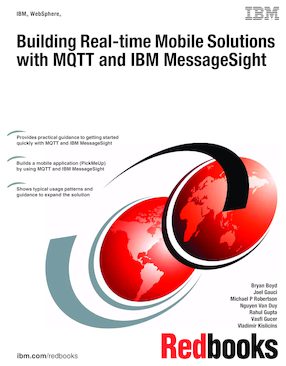Abstract
MQTT is a messaging protocol designed for the Internet of Things (IoT). It is lightweight enough to be supported by the smallest devices, yet robust enough to ensure that important messages get to their destinations every time. With MQTT devices, such as energy meters, cars, trains, mobile phones and tablets, and personal health care devices, devices can communicate with each other and with other systems or applications.
IBM® MessageSight is a messaging appliance designed to handle the scale and security of a robust IoT solution. MessageSight allows you to easily secure connections, configure policies for messaging, and scale to up to a million concurrently connected devices.
This IBM Redbooks® publication introduces MQTT and MessageSight through a simple key fob remote MQTT application. It then dives into the architecture and development of a robust, cross-platform Ride Share and Taxi solution (PickMeUp) with real-time voice, GPS location sharing, and chat among a variety of mobile platforms. The publication also includes an addendum describing use cases in a variety of other domains, with sample messaging topology and suggestions for design.
Table of Contents
Chapter 1.Overview of MQTT
Chapter 2. Getting started with MQTT
Chapter 3. Overview of IBM MessageSight
Chapter 4. Typical network topology, messaging patterns, and considerations
Chapter 5. IBM MessageSight and the key fob remote application
Chapter 6. Overview of the PickMeUp application
Chapter 7. PickMeUp messaging scenario
Chapter 8. PickMeUp MQTT on iOS
Chapter 9. PickMeUp MQTT on Android
Chapter 10. PickMeUp MQTT in HTML5 applications
Chapter 11. Download, deploy, and run PickMeUp in iOS, Android, and HTML environments
Appendix A. The MQTT protocol
Appendix B. Additional material
